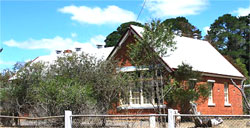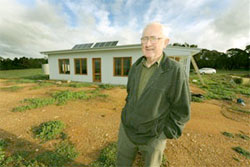Diana Kupke Writes

Places that are part of my ancestry
Lexton in Victoria
Home of the Manns
Lexton, a small country town 161 kilometres north west of Melbourne, was the birthplace, in 1910, of my father, Thomas Edwin Mann.
Prior to the discovery of the area by Major Thomas Mitchell in 1836, an Aboriginal clan, Galgal Balug (people with tame dogs) lived there. Mitchell reported favourably on the area and soon after new settlers - and sheep - moved into what was then known as Burnback. By 1845 Burnbank included a post office, the Burnbank Inn, a shop, and blacksmith and wheelwright's premises. The official post office opened three years later. The Burnbank Inn was replaced by the Pyrenees Hotel in 1859 and it still stands today.
By 1851 a gold find at a nearby sheep farm saw the escalation of Burnbank which was the closest town. The gold ran out but Lexton, as it was renamed in 1854, remained a small but thriving area settled mainly by sheep farmers. Numerous large farms dotted the area including Ercildoune which my father frequently mentioned as he had done contract shearing there and I have dim memories of him saying he was a ringer.
My great great great grandfather, Michael Lyons, made a successful application for land in Lexton and built a four room school there with the assistance of a Father Bleasdale. In 1850 Michael was a trustee of the Lexton school committee along with Compton Ferris and James Dunne.

Above, Lexton School
As well as wool production, industry in the area also includes saw mills and transport. Numerous sporting type activities take place there. Lexton may be small but it has an amazing array of groups including the Lexton Community Club, Lexton Progress Association Inc., Lexton Neighbourhood Watch, Lexton Public Hall Ladies Committee, Victorian Farmers Federation, Management Committee for Community Centre, Lexton Landcare Group, Lexton Rural Fire Brigade, and the Lexton Cemetery Trust.
The present Community Centre was originally the second court house which was built in 1874. At some time the building then became the headquarters of Lexton Shire.
John Morgan's energy efficient house at Lexton

A house has been built in Lexton which is considered, by the Alternative Technology Association, to be the most energy efficient home in Australia. It has a nine star rating, is 80 square metres in size, and was built for less than $150,000. New houses in Victoria have six stars as the benchmark.

Galaxy Hill House several years after being built.
Owner John Morgan has been interested in renewable energy since reading about solar hot water half a century ago. His home has 12 solar panels and the inner walls are made from 90 mm concrete blocks to aid with thermal efficiency. Obviously the house works as when the temperature outside was 45.4 degrees celsius, Mr Morgan's house was 33.9 degrees celsius. During the past two years the internal daily temperature has averaged about 16 degrees in winter and 25 degrees in summer.
The building has a northeast orientation to capture maximum winter sun and to avoid summer rays, with extensive glazing along the face to heat the living area.
After several years in the house, John says it is still comfortable and does not cost him anything to run.
"It is very comfortable and needs no heater nor airconditioning and it is not connected to the electricity or water grids so I'm fully independent," said John.
"Galaxy Hill, named because of my interest as an amateur astronomer, is the fourth in a sequence of zero emissions houses I have designed for us, dating back to the early seventies."